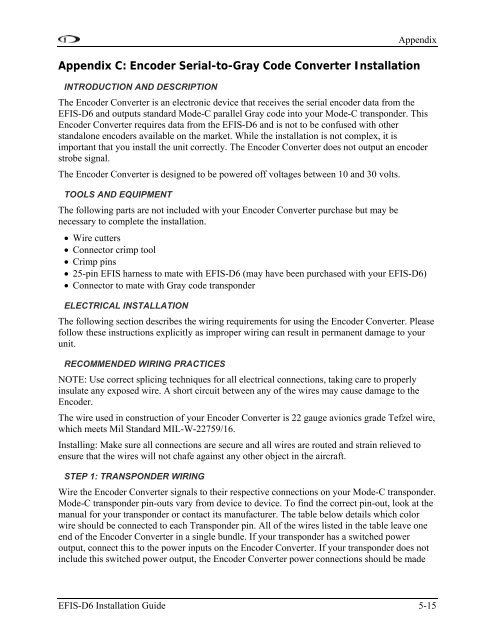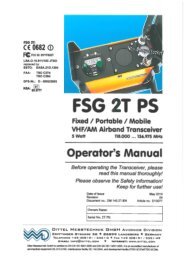EFIS-D6 Installation Guide
EFIS-D6 Installation Guide
EFIS-D6 Installation Guide
You also want an ePaper? Increase the reach of your titles
YUMPU automatically turns print PDFs into web optimized ePapers that Google loves.
Appendix<br />
Appendix C: Encoder Serial-to-Gray Code Converter <strong>Installation</strong><br />
INTRODUCTION AND DESCRIPTION<br />
The Encoder Converter is an electronic device that receives the serial encoder data from the<br />
<strong>EFIS</strong>-<strong>D6</strong> and outputs standard Mode-C parallel Gray code into your Mode-C transponder. This<br />
Encoder Converter requires data from the <strong>EFIS</strong>-<strong>D6</strong> and is not to be confused with other<br />
standalone encoders available on the market. While the installation is not complex, it is<br />
important that you install the unit correctly. The Encoder Converter does not output an encoder<br />
strobe signal.<br />
The Encoder Converter is designed to be powered off voltages between 10 and 30 volts.<br />
TOOLS AND EQUIPMENT<br />
The following parts are not included with your Encoder Converter purchase but may be<br />
necessary to complete the installation.<br />
• Wire cutters<br />
• Connector crimp tool<br />
• Crimp pins<br />
• 25-pin <strong>EFIS</strong> harness to mate with <strong>EFIS</strong>-<strong>D6</strong> (may have been purchased with your <strong>EFIS</strong>-<strong>D6</strong>)<br />
• Connector to mate with Gray code transponder<br />
ELECTRICAL INSTALLATION<br />
The following section describes the wiring requirements for using the Encoder Converter. Please<br />
follow these instructions explicitly as improper wiring can result in permanent damage to your<br />
unit.<br />
RECOMMENDED WIRING PRACTICES<br />
NOTE: Use correct splicing techniques for all electrical connections, taking care to properly<br />
insulate any exposed wire. A short circuit between any of the wires may cause damage to the<br />
Encoder.<br />
The wire used in construction of your Encoder Converter is 22 gauge avionics grade Tefzel wire,<br />
which meets Mil Standard MIL-W-22759/16.<br />
Installing: Make sure all connections are secure and all wires are routed and strain relieved to<br />
ensure that the wires will not chafe against any other object in the aircraft.<br />
STEP 1: TRANSPONDER WIRING<br />
Wire the Encoder Converter signals to their respective connections on your Mode-C transponder.<br />
Mode-C transponder pin-outs vary from device to device. To find the correct pin-out, look at the<br />
manual for your transponder or contact its manufacturer. The table below details which color<br />
wire should be connected to each Transponder pin. All of the wires listed in the table leave one<br />
end of the Encoder Converter in a single bundle. If your transponder has a switched power<br />
output, connect this to the power inputs on the Encoder Converter. If your transponder does not<br />
include this switched power output, the Encoder Converter power connections should be made<br />
<strong>EFIS</strong>-<strong>D6</strong> <strong>Installation</strong> <strong>Guide</strong> 5-15
















